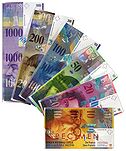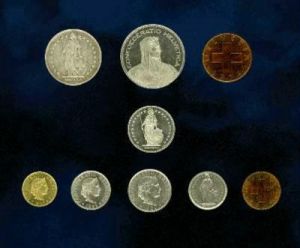CHF发表评论(0)编辑词条
Swiss franc
The franc (German: Franken, French and Romansh: franc, Italian: franco; code: CHF) is the currency and legal tender of Switzerland and Liechtenstein; it is also legal tender in the Italian exclave Campione d'Italia. Although not formally legal tender in the German exclave Büsingen (the sole legal currency is the euro), it is widely used on a day-to-day basis. The Swiss National Bank issues banknotes and the federal Swissmint issues coins.
The Swiss franc is the only version of the franc still issued in Europe. The smaller denomination, a hundredth of a franc, is a Rappen (Rp.) in German, centime (c.) in French, centesimo (ct.) in Italian, and rap (rp.) in Romansh. The ISO code of the currency used by banks and financial institutions is CHF, although "Fr." is used by most businesses and advertisers; some use SFr.; the Latinate "CHF" denotes Confoederatio Helvetica franc, because Latin is used as the neutral language representing the country given its tetralingual populace.
Coins
In 1850, coins were introduced in denominations of 1, 2, 5, 10, and 20 centimes and ½, 1, 2, and 5 francs, with the 1 and 2 centimes struck in bronze, the 5, 10, and 20 centimes in billon, and the franc denominations in .900 fine silver. Between 1860 and 1863, .800 fine silver was used, before the standard used in France of .835 fineness was adopted for all silver coins except the 5 francs (which remained .900 fineness) in 1875. In 1879, billon was replaced by cupro-nickel in the 5 and 10 centimes and by nickel in the 20 centimes. In 1883, gold 20 franc coins were introduced, followed by gold 10 franc coins in 1911. Gold coins were struck for circulation until 1935.
Banknotes
In 1907, the Swiss National Bank took over the issuance of banknotes from the cantons and various banks. It introduced denominations of 50, 100, 500 and 1000 francs. 20 franc notes were introduced in 1911, followed by 5 franc notes in 1913. In 1914, the Federal Treasury issued paper money in denominations of 5, 10 and 20 francs. These notes were issued in three different versions: French, German and Italian. The State Loan Bank also issued 25 franc notes that year. In 1952, the National Bank ceased issuing 5 franc notes but introduced 10 franc notes in 1955. In 1996, 200 franc notes were introduced whilst the 500 franc note was discontinued.
Eight series of banknotes have been printed by the National Bank, six of which have been released for use by the general public. The sixth series from 1976, designed by Ernst and Ursula Hiestand, depicted persons from the world of science. It has been recalled and replaced and will lose any value on 1 May 2020. As of 2006, a large number of notes from this series have not yet been exchanged, even though they have not been legal tender for more than 5 years; for example, the value of those 500 franc banknotes still in circulation represents 167.4 million Swiss francs.
Some security features (Iriodin digits and Kinegram) of the 20 Swiss francs banknote.
The seventh series was printed in 1984, but kept as a "reserve series", ready to be used if, for example, wide counterfeiting of the current series suddenly happened. When the Swiss National Bank decided to develop new security features and to abandon the concept of a reserve series, the details of the seventh series were released and the printed notes were destroyed.
The current, eighth series of banknotes was designed by Jörg Zintzmeyer around the theme of the arts and released starting in 1995. In addition to a new design, this series was different from the previous one on several counts. Probably the most important difference from a practical point of view was that the seldom-used 500 franc note was replaced by a new 200 franc note; this new note has indeed proved more successful than the old 500 franc note. The base colours of the new notes were kept similar to the old ones, except that the 20 franc note was changed from blue to red to prevent a frequent confusion with the 100 franc note, and that the 10 franc note was changed from red to yellow. The size of the notes was changed as well, with all notes from the 8th series having the same height (74 mm), while the widths were changed as well, still increasing with the value of the notes. The new series contains many more security features than the previous one; many (but not all) of them are now visibly displayed and have been widely advertised, in contrast with the previous series for which most of the features were kept secret.
瑞士法郎
瑞士法郎(Swiss franc)是瑞士(Switzerland)的法定货币,由瑞士的中央银行发行。也是列支敦斯登(Liechtenstein)的法定货币,ISO 4217 货币代码 CHF。瑞士法郎是一种硬通货。瑞士的大部分邻国使用欧元。瑞士境内亦有商铺、机构通行欧元。
1法郎=100生丁(centime或者德语的Rappen)
历史
1848年瑞士宪法赋予联邦政府发行货币的职责,在那之前,每个州都有发行自己的货币并拥有自己的货币制度。法郎在1850年获得通过成为瑞士的法定货币,并确定1法郎=100生丁(centime或者德语的Rappen)。瑞士法郎在被确立为国家货币时,其价值与法国法郎等同。
虽然联邦是法郎的唯一发行者, 但是1910年之前,私人的银行被允许发行他们自己的钞票。1907年瑞士国家银行建立,并从1910年起一直是唯一的钞票和硬币发行机构。
瑞士法郎在上世纪一直是最稳定的货币,并在相当长的时间内被视为避风港货币,因此在瑞士几乎总是零通胀,并且货币依托有40%的黄金储备。
目前银行发行的是第七套纸币,面额为10 , 20 , 50 , 100 , 200和1000法郎。瑞士纸币有众多的防拷贝技术的特点,是极其困难甚至可能是无法仿制的。
在2005年11月份举行的瑞士新版系列纸钞设计比赛中, Manuela Pfrunder的设计名列第二,而Manuela Pfrunder的修改特别适合新版系列纸钞。2007年2月23日,瑞士国家银行理事会举行了一个专门会议,就瑞士新版纸钞方案进行研究。会议决定按照金融管理当局的推荐,对瑞士女设计师Manuela Pfrunder的设计作品作进一步的完善。并在2008年中期,至少有一种面额的纸钞可以具备生产条件。
以前首次发行于1976年的第六套钞票不再可兑现,但在2020年前还可以通过瑞士国家银行进行兑换。而第五套纸币已经不在可兑现并且是毫无价值的,它唯一的价值就是收藏。在2000年第五套变得毫无价值时,约有24400万瑞郎还没有兑现。自1880年以来,硬币大多数的设计没有改变,除了金属成分。
硬币的面值有1, 5, 10, 20, 50 生丁和 1, 2, 5 法郎。1生丁的硬币实际上已经不在使用。2005年政府说由于高昂的制造费用,考虑取消1生丁和5生丁硬币的流通,但由于公众的反对和担心物价上涨,2006年2月最后决定只取消1生丁硬币的流通。过去还有一个2生丁的硬币,但在1974年以后就不再是法定硬币。现在面值5生丁的硬币成为瑞士法郎中最小的货币单位,但造一枚5生丁硬币花费的价值为6生丁,造价比面值还要高出1生丁。近年来成为了瑞士联邦财政部和公民争论的焦点。
瑞士法郎纸币
瑞士法郎的印刷有其独到之处,即用瓦楞线组成的人像是用深凹版印刷,形成一个细微的波纹水平线网,纬线厚度和高度变化使肖像显出明亮区和阴暗区,垂直观察可见印刷的线条和分隔它们的空间,肖像显示显示正常形象,倾斜观察,高的线条遮住了白的空档,阴暗区变得密集,肖像变为深色,四根白色防伪线条清楚的显现出来。钞票的中部使用了兰色荧光油墨;地印图案巧妙的隐藏在花饰图案中。
新系列瑞士法郎纸币用色明快,设计与印工皆精。在版式和防伪技术上都有很大的改变,将横版改为竖版,正在左侧由字母“A-H”划分域均有一项防伪措施:水印为正面人像;安全线是开窗式;
钞票的上方有“十”字形对印;正面中间有动态全息标,全息标内有面额数字;正面中间的几何图形内有缩印文字;紫光灯下有荧光纤维丝和面额数字,正面人像的一半有反光。
10元纸币上为瑞士出生的建筑师勒•柯布西耶的头像,虽然他的重要建筑活动多发生在瑞士以外。100元纸币上为雕塑家吉柯梅蒂和他的作品。1000元纸币上为文化歷史学家雅各•布克哈特。
瑞士法郎硬币 (如右图)
与“CHF,瑞士法郎,货币”相关的词条
→如果您认为本词条还有待完善,请 编辑词条
词条内容仅供参考,如果您需要解决具体问题
(尤其在法律、医学等领域),建议您咨询相关领域专业人士。
0

同义词: 暂无同义词
关于本词条的评论 (共0条)发表评论>>










